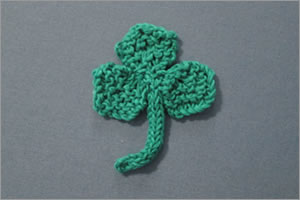In observance of St. Patrick’s Day, I decided to knit and give my avid knitter wife an Irish Shamrock. She really liked the Valentine’s Day Hearts that I knitted for her, so I can only imagine and hope for a similar outcome. Over the course of this new adventure, knitting the Irish Shamrock, I learned a few new knitting skills and I also learned a few new things about shamrocks. Let me tell you all about it.
I also learned that there is a difference between a shamrock and a four leaf clover. Shamrocks and four-leaf clovers are often confused or used interchangeably and many Americans, like me, think that a four-leaf clover is a shamrock that brings you good luck. Well, not so fast.
The four-leaf clover is rare. The odds of finding one in a clover patch is 1 in 10,000. Because of this rarity, finding a four-leaf clover is considered to be a lucky feat. Hence, the four-leaf clover is a symbol of good luck.
Now, the three-leaf clover, shamrock, is also considered lucky. Druids, the learned class of the ancient Celts, believed that shamrocks had magical power and that by carrying them on their possession they could see and escape from evil spirits. But, the bottom line is that the three-leaf clover is what the people of Ireland refer to as a shamrock. So when in Ireland or honoring St. Patrick’s Day, make sure your shamrock has three, not four, leaves.
Now on to knitting a shamrock. There are lots of patterns on the internet for knitting a shamrock. Some are very fancy and some are very simple. I chose a very simple pattern from Kristen McDonnell at Studio Knit. Below are Kristen’s instructions for making the leaf of the shamrock:
- Cast on 12 Stitches
- Row 1 – K4, SSK, K2Tog, K4 (10 rem)
- Row 2 – Knit All
- Row 3 – K3, SSK, K2Tog, K3 (8 rem)
- Row 4 – Knit All
- Row 5 – K2, SSK, K2Tog, K2 (6 rem)
- Row 6 – Knit all
- Row 7 – SSK, BO2, SSK, BO
To knit this pattern my avid knitter wife gave me three things:
- Clover Bamboo Double Point Knitting Needles 7″ – 5/pkg; US Size 7
- Silver Swan Cotton Spa Worsted Yarn – 15 Emerald
- Boye Knit Tally / Row Counter
This was the first time I knitted with Bamboo needles and I was very pleased with their feel and how nicely they held the yarn. The feel of the yarn on the needles wasn’t too grabby or too slippery, but just right. The Silver Swan Cotton Spa Worsted yarn had a nice weight to it. Initially, I didn’t think I needed to use the row counter, but after losing track of which row I was knitting and making a mistake in my first leaf I changed my mind. The row counter was actually a big help and kept me from making the mistake of losing the row count again.
I liked this shamrock pattern because it was very simple. Yet, as simple as it was, I still encountered a few problems. First, I thought I knew how to do the slip, slip, knit (SSK) stitch. But, I was slipping the stitches off incorrectly, inserting my right-hand needle from the wrong side of the loop (right to left). This made a mess of my knitting, but after a bit of corrective schooling from my avid knitter wife, I was back on track.
Another problem I had was that old nemesis of mine, yarn tension. I still knit with too much tension, though I am getting a little better. Too much tension was making it really hard for me to slip, slip, knit (SSK) and to knit two together (K2Tog).
And my last problem was my lack of concentration. Even with a pattern as simple as this one, I forgot which row I was on and skipped one of the “knit all” rows. As a result, my yarn ends weren’t in the right place and the shape of my leaf wasn’t the same as in the pattern picture. That’s when I decided to use the row counter.
After knitting up three acceptable leaves, I then took on the stem. For this, I knitted up my first I-Cord using double pointed needles for the first time. I cast on four stitches and then went about knitting the stem.
With three leaves and a stem, all I had to do now was to sew it all together. I am not that good at sewing, but I managed to keep one side of the shamrock flat and clean with no knots, and used the other side for knots and sewing in the loose ends.
This project was a fun adventure and I highly recommend it for beginner knitters like me. It doesn’t take too long to complete and along the way you really pick up some new skills and techniques. And if you struggle with yarn tension like I do, then this project is good for improving tension, making better stitches, and being able to decrease with SSK or K2Tog stitches.
Best of all, the shamrock that this pattern produces really looks good. It will have you in style on St. Patrick’s Day and keep you safe from the pinch of the leprechaun.

